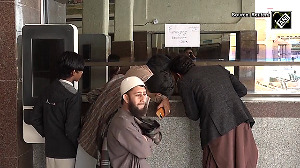Day 1: RBI puts UWB under moratorium.
Day 2: Leading banks join race for UWB.
Day 3: RBI gives away UWB to IDBI.
In other words, United Western Bank went up in smoke in exactly three days. If banks can disappear as quickly as that, what happens to their customers and shareholders? This question has gained more significance now, as UWB is the second bank to be placed under moratorium within this year alone.
Shareholders and customers
As a depositor, if your bank is put under moratorium, you can withdraw up to Rs 10,000 from your savings bank account or current account or any other deposit account. You cannot withdraw money through the ATM, but have to go to a branch of the bank. Fortunately for customers, in banks like UWB, which are under the Deposit Insurance and Credit Guarantee Corporation's scheme, fixed deposits up to Rs 100,000 are protected.
However, shareholders do not gain anything as the bank's net worth has eroded. For example, shareholders of Global Trust Bank and Nedungadi Bank, which were put under moratorium and were merged with Oriental Bank of Commerce and Punjab National Bank, respectively, were not offered any compensation at all (See: Merger Moves).
Distribution of surplus, if any, would be decided at the end of a 12-year period. However, UWB shareholders are fortunate. Market sources confirm that they would be paid Rs 28 per share upfront.
Weak banks
RBI has historically placed weak banks under moratorium before finding the right partner to merge them with. Ganesh Bank of Kurundwad was recently put under moratorium, before being merged with the Federal Bank.
Though RBI does not publish a list of financially unstable banks, a look at a bank's balance sheet gives an idea of its financial strength. RBI guidelines on ownership and corporate governance in private banks stipulate that banks should maintain a minimum net worth of Rs 300 crore (Rs 3 billion).
However, a number of banks do not conform to this. Nainital Bank, for instance, has net worth of only Rs 67 crore (Rs 670 million). Other private banks that have capital less than Rs 300 crore as on 31 March 2006 include Lakshmi Vilas Bank, City Union Bank and Dhanalakshmi Bank. Over half a dozen unlisted banks also have a low capital base. (See: Below The Mark) This list includes Catholic Syrian Bank, Bharat Overseas Bank and Sangli Bank.
Bank's viability
The most important indicators of a bank's financial health are - net profit, capital adequacy ratio and non performing assets.
Net profit is the funds left with the bank after all its expenses are met. Capital Adequacy Ratio helps the bank decide upon the extent of losses it can absorb without becoming defunct.
According to RBI, a bank must maintain a stipulated CAR of 9 per cent. Non-performing assets are loans with poor chances of recovery. UWB, for instance, incurred net losses of Rs 98.64 crore (Rs 986 million) and Rs 106.48 crore (Rs 1.06 billion) during 2004-05 and 2005-06, respectively.
Its net NPAs were 5.66 per cent as on 31 March 2006, as compared to the industry average of 1.97 per cent. The bank's CAR turned negative at -0.3 per cent as on 30 June, 2006.
Why consolidate?
Cherian Varghese, ex-chairman and MD, Union Bank of India, explains, "Financial services are becoming more complex. Today, transactions and banks' exposures are not defined within national realms. So it is necessary to have large balance sheets in order to muscle out competition by global banks, in India and abroad."
The finance minister and RBI have been inducing banks for successful marriages, either voluntarily or forcefully, to make them globally competitive. One driving force for consolidation is capital inadequacies as only well-capitalised banks will be in a position to face competition from abroad as India opens up.
Once Basel II norms (which will require banks to have a minimum CAR of 12.5 per cent as opposed to 9 per cent currently) come into play by the end of 2006, banks will need more capital if they want to grow their loan books.
What do you gain?
Mumbai-based retiree, Manas Kamath, 50, has been banking with UWB for the past seven years. When we asked him about its acquisition of UWB, he said the most important things for him were the bank's proximity to where he lived, and its quality of service. As long as these conditions were met, he had no complaints.
Says Sreenivasalu Raju, loan manager with Andhra Bank, "As merged entities will compete with global peers, their service quality will certainly improve. Also, benefits of cost-cutting exercises would ultimately trickle down to the customer." An IBA official points out that consolidation would help banks cross rural bridges which could mean swifter remittances in these areas. Overseas banking would also become easier.
Each bank is a niche player in a certain field. By joining hands with each other, banks can retain the advantages they enjoy in that area and also make use of the economies of scale enjoyed by their partner bank. On the whole, as a customer, you stand to gain as both banks tap their respective strengths.
What do you lose?
Leslie Fernandez was banking with ANZ Grindlays prior to its merger with Standard Chartered Bank. On his Grindlays account, he had opted for an insurance policy with Medicare with an auto debit facility.
When he went to the bank's Fort branch in Mumbai to get an update on his insurance plan, he realised that SCB was not aware of the insurance relationship and had no point of contact at Medicare. "When two banks merge, customers who have opted for third-party products are affected," says an official of the Fort branch.
According to IBA's chief executive, H N Sinor, consolidation will definitely mean closure of branches in the same vicinity, which may inconvenience customers. However, as these banks have a vast network, the impact will be minimal.
Analysts and bankers have mixed responses to bank mergers. But, the fact is that what bank consolidations offer, more than compensates for what is lost. Clearly consolidation is the way ahead.
As Sinor puts it, "The positive outcomes of this exercise outnumber the negative ones. Still, the ultimate responsibility of ensuring that the move benefits all, and is not detrimental to the interests of the customer, rests on the shoulders of the monetary authorities."
|
Merger Moves | ||
|
Banks |
Merged with |
Period |
|
United Western Bank |
IDBI Bank |
6-Sep |
|
Lord Krishna Bank |
Centurion Bank |
6-Aug |
|
Ganesh Bank of Kurundwad |
The Federal Bank |
6-Jan |
|
Bank of Punjab |
Centurion Bank |
5-Sep |
|
IDBI Bank |
IDBI Limited |
5-Apr |
|
Global Trust Bank |
Oriental Bank of |
4-Jul |
|
|
Commerce |
|
|
Nedungadi Bank |
Bank of Punjab |
2-Nov |
|
Benares State Bank |
Bank of Baroda |
2-Jun |
|
ICICI Limited |
ICICI Bank |
2-Jan |
|
Bank of Madura |
ICICI Bank |
1-Mar |
|
Times Bank |
HDFC Bank |
Feb-00 |
|
Sikkim Bank |
Union Bank |
Dec-99 |
|
Bareilly Corporation Bank |
Bank of Baroda |
Jun-99 |
|
Below The Mark |
|
| |
|
Banks |
Net worth |
CAR |
NPA |
|
| |||
|
Sangli Bank |
86 |
13.7 |
6.6 |
|
Dhanlakshmi Bank |
134 |
13.6 |
6.7 |
|
Catholic Syrian Bank |
194 |
11.2 |
4.7 |
|
City Union Bank |
203 |
13.4 |
6.4 |
|
Lakshmi Vilas Bank |
227 |
13.8 |
5.4 |
|
South Indian Bank1 |
395 |
9.9 |
4.6 |
|
Tamilnad Mercantile Bank1 |
477 |
21.07 |
5 |
|
These banks have been named because their net worth is below the stipulated level of Rs 300 crore. | |||






 © 2025
© 2025